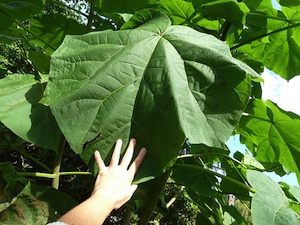As the first week at the Outdoor School* ended and the weekend arrived, I thought about what to write about this week. I had made it a goal to learn some common night-singing insect calls by visiting the
Songs of Insects website and while I haven't done that yet, Sunday isn't over either. After returning from Giant to get some milk, I went for a walk to find some subjects for this weeks post. I decided to settle on three invasive plants that have appeared on the property over the summer.
We were introduced to the first during orientation while walking from the group challenge field over the Pennypack Creek that runs through the property. The plant's huge leaves were what surprised me the most, as well as seeming so tropically out of place with the mid-Atlantic environment they were now living in. Initially we were stumped as to their identity, but after one of my bosses did some research, he determined that they were Empress or Princess Trees. Their scientific name is
Paulownia catalpa and they resemble the native Catalpa (
Catalpa bignoniodes/speciosa) because of their large, heart-shaped leaves and similar, tube-shaped flowers.
 |
| The Paulownia on the left and the Catalpa is on the right |
 |
| These leaves can get big! |
So called because of being named after royalty in the Netherlands, the genus
Paulownia is native to south China and was initially brought over for ornamental purposes. But like so many non-native trees, shrubs, and wildflowers, they escaped their garden homes with ease and infiltrated the surrounding woods and fields. The empress trees live up to their reputation by growing large and fast. Given enough space and sunshine, they can grow very tall and wide, and are regularly pollinated due to their large lilac and white blossoms.
 |
| The triangular leaves, combined with a spiny petiole, circular leaves on the stem, and small berry clusters all point to Mile-a-Minute or Asiatic Tearthumb. |
While those trees were shocking in both size and growth speed, the worst surprise came in the form of a devil-tailed vine and its smaller and skinnier grassy cohort. The devil-tailed vine I speak of is the dreaded Mile-a-Minute vine (
Persicaria perfoliata) that conservationists, landowners, and gardeners scorn above all. While intially appearing in the late 1800s in the East and Pacific Northwest, those colonies were eradicated before they could spread further. However, it was reintroduced with rhododendrons in York County, PA in the 1930s and 40s and has since spread up to 300 miles away from its original location. Often called "kudzu of the North", it grows up to 30 feet in a single growing season and smothers other native plants to gain dominance in its surroundings.
 |
| It superficially resembles flimsy bamboo or even a lanky "Lucky Bamboo", but it's actually related to the knotweed family |
The omnipresent non-native is a woodland-dwelling grass is called Japanese Stiltgrass (
Microstegium vimineum). It was accidentally introduced by shipping companies in the early 20th century when shipments of porcelain from China were packed with the plant material. It covers forest floors, obscuring inconveniences such as Poison Ivy (
Toxicodendron radicans) and shading out native species. A common late summer and fall plant called Pennsylvania Smartweed (
Polygonum pensylvanicum) is often seen growing amongst this invader along our trails and has a structure that one could mistaken for the grass. It differs from the former due to its pink flower stalk and larger, greener leaves.
Though I know that the complete removal of these plants is unlikely, I would like to think that people on the poperty are at least aware and thinking of ways to remove it in order to promote better biodiversity and conservation on the property as a whole. I'm going to inquire myself as to what might be done in the future to stop these plants from spreading, but for now, we are having to live side by side with these noxious and annoying invaders.
*The opinions and statements made on this blog are my own and do not reflect the attitudes, views, or goals of the Outdoor School and College Settlement Camps.






Comments
Post a Comment